Navigating the complexities of RAF General Damages Claims can be overwhelming.
Whether you’ve been in a motor vehicle accident or are supporting a loved one, understanding these claims is crucial.
Dive into our comprehensive guide for insights on making a successful claim and getting the compensation you deserve.
Introduction: Understanding General Damages in Motor Vehicle Accidents
When it comes to the aftermath of a motor vehicle accident, the financial toll is often clear and immediate. However, what often goes unspoken are the non-monetary losses that can deeply affect a person’s life. This is where the concept of general damages claims comes into play.
General Damages (GD) refer to the compensation awarded for the pain, suffering, and loss of amenities of life endured due to serious injuries sustained in a motor vehicle accident. Unlike specific damages, which are quantifiable losses like medical bills or lost wages, general damages cover those losses that are not easily measured in monetary terms.
Understanding general damages is crucial for anyone involved in a motor vehicle accident. It’s not just about getting reimbursed for what you have spent or lost financially; it’s also about acknowledging and compensating for the profound impact the accident has had on your personal well-being and quality of life.
The Road Accident Fund (RAF) in South Africa plays a pivotal role in this context. It offers a means to seek compensation for those suffering from the non-financial repercussions of motor vehicle accidents.
But why is it important to understand general damages, and what exactly does this encompass in the realm of motor vehicle accidents?
Let’s delve into these questions to gain a clearer picture of this vital aspect of post-accident recovery and compensation.
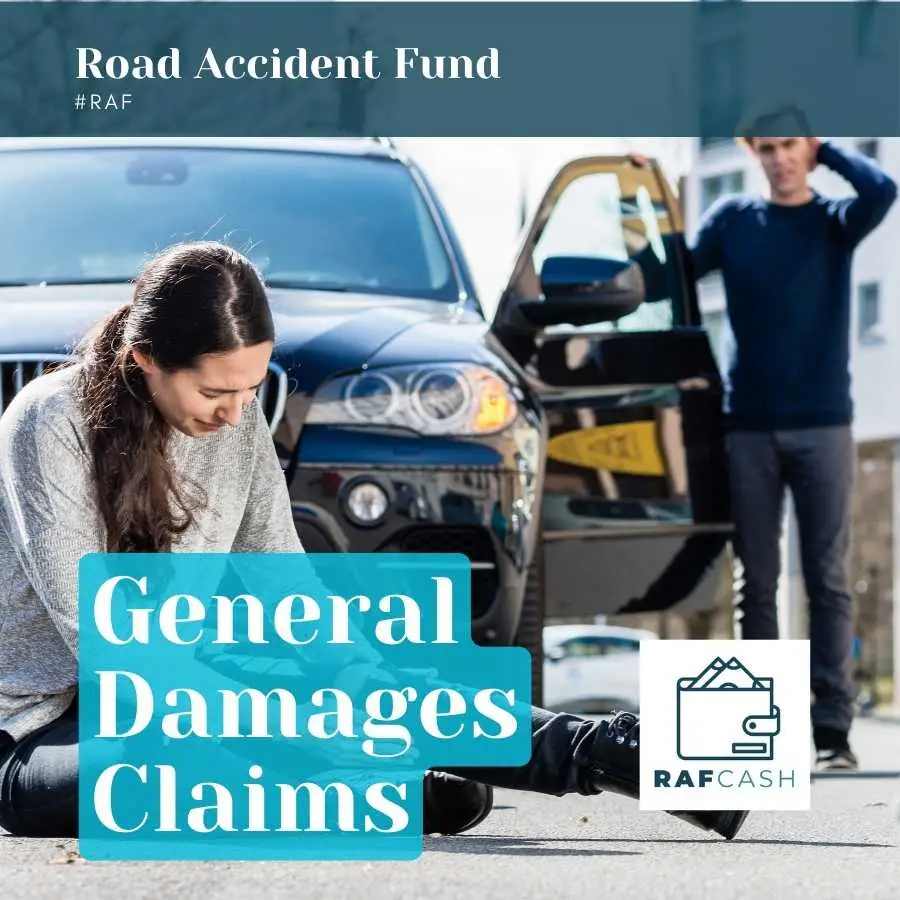
Understanding General Damages: Beyond the Monetary Impact
What are General Damages?
According to Ndumiso Dlamini, pre-assessment senior officer with the registration management department, general damages refers to “damages for pain and suffering and loss of amenities of life that the claimant has suffered due to serious injuries sustained from a motor vehicle accident.”
General damages, also known as ‘non-monetary losses’, are intended to compensate for non-financial losses. These include pain and suffering, emotional distress, loss of enjoyment of life, physical disfigurement, and loss of consortium or companionship.
General damages (or ‘pain and suffering damages’) in the context of motor vehicle accidents are fundamentally about the intangible, personal losses that don’t come with a price tag.
These damages cover a range of non-monetary losses that significantly impact the quality of life and emotional well-being of an individual following an accident.
Non-Monetary Losses Covered
The types of non-monetary losses which are covered under the GD heading include:
- Pain and Suffering: This encompasses both the physical pain and the emotional distress experienced due to the injuries. It includes ongoing discomfort, the trauma of the recovery process, and any chronic pain resulting from the accident. Pain and suffering may also be mental. For example, damages may be awarded for psychological or psychiatric injury.
- Loss of Amenities of Life: This aspect recognizes the loss of enjoyment in life that a person suffers post-accident. For instance, if you were an avid runner and can no longer run due to your injuries, this loss of a cherished activity falls under general damages.
- Emotional Distress: Beyond physical pain, accidents can leave deep psychological scars. Anxiety, depression, and post-traumatic stress disorder (PTSD) are common after traumatic events like road accidents.
- Physical Disfigurement: If the accident results in scars, loss of limbs, or other forms of disfigurement, general damages compensate for the emotional and psychological impact of these changes in appearance.
- Loss of Consortium: In legal terms, this refers to the deprivation of the benefits of a family relationship due to injuries, including affection, solace, comfort, companionship, society, assistance, and sexual relations.
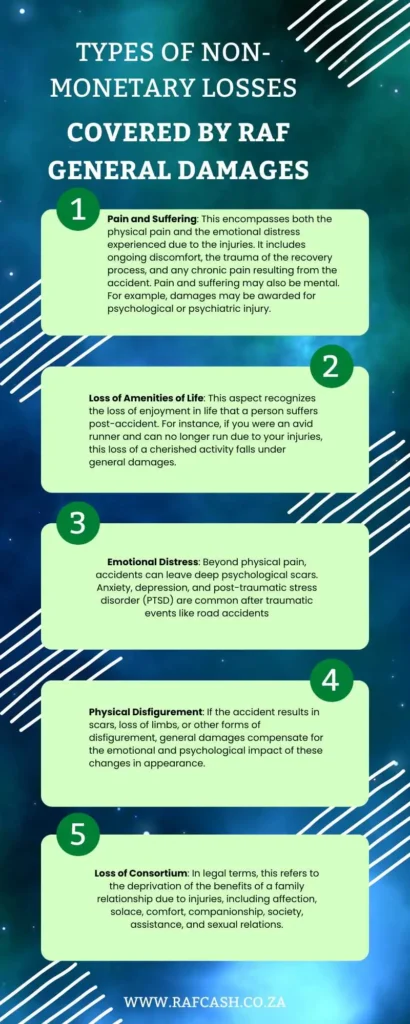
Differentiation from Specific Damages
While general damages focus on the qualitative aspects of loss, specific damages are all about quantifiable financial losses. Here’s how they differ:
- Loss of Earnings/Medical Expenses (Specific Damages): These are the measurable financial impacts of an accident. Loss of earnings refers to the income you have lost (and will potentially lose) due to your inability to work post-accident. Medical expenses include hospital bills, medication costs, rehabilitation fees, and any other healthcare-related costs incurred due to the accident.
- General Damages: Here, the focus shifts from the wallet to the heart and soul. How has the accident changed your life in ways that money can’t measure? It’s about the loss of life’s pleasures, the daily pain, and the emotional turmoil that doesn’t have a receipt.

Nuances in South Africa
South African law may have specific guidelines or legal precedents that dictate how general damages are assessed and quantified. The approach can differ from other jurisdictions, where factors like societal values and legal principles play a significant role.
South African courts don’t typically award compensation for grief, bereavement, loss of companionship or other forms of non-clinical distress.
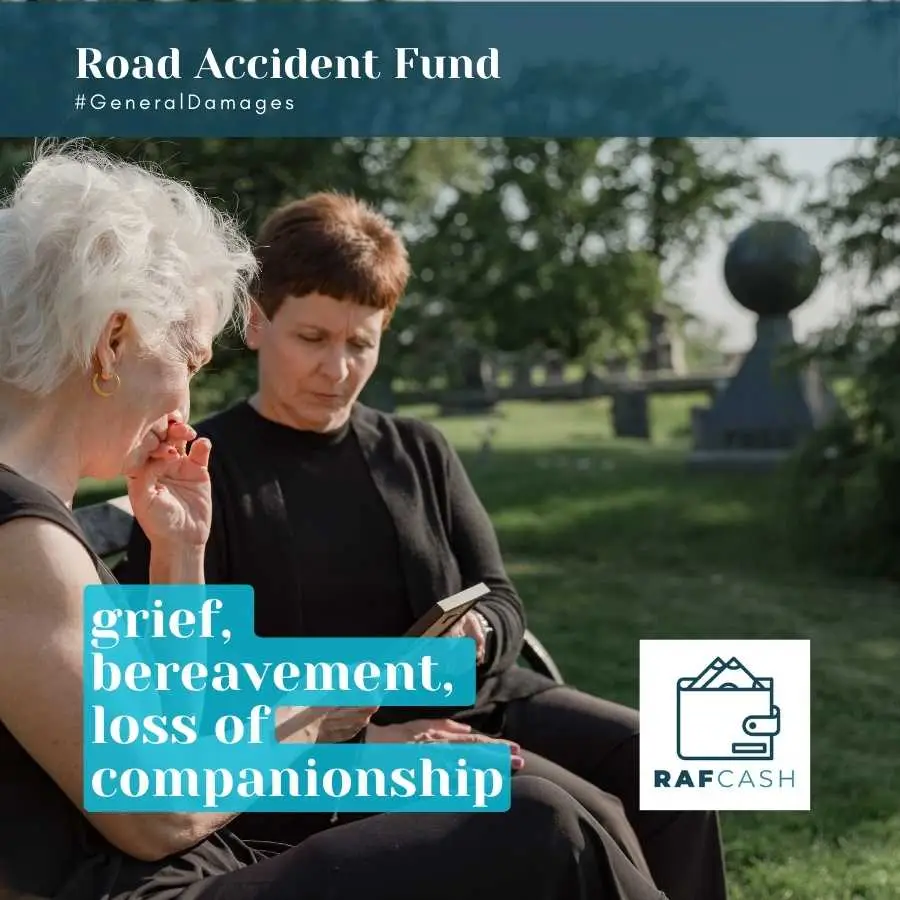
In some countries, including the United States, these damages are recognised.
Understanding the difference between these two types of damages is essential for anyone involved in a motor vehicle accident. It shapes the nature of the claim filed with the RAF and highlights the breadth of impact an accident can have on an individual’s life.
As we navigate the complexities of general damages claims, it’s important to remember that the value of these claims lies not in their monetary worth. Rather, value lies in their ability to acknowledge and compensate for the profound personal losses suffered.
Assessment and Quantification of General Damages: Navigating the Intangibles
In the realm of Road Accident Fund (RAF) claims, assessing and quantifying general damages is a nuanced process. It’s about delving into the depth of an individual’s suffering and loss, which, unlike financial losses, can’t be neatly tallied up. This section sheds light on how these intangible damages are evaluated and quantified in South Africa.
Assessing the Severity and Impact of Injuries
The assessment for general damages often involves considering the severity and impact of the injuries on the individual’s life, including long-term effects and the degree of pain and suffering.
General damages compensation in South Africa is at the discretion of the courts. This can involve:
- Medical Evaluation – The first step involves a thorough medical examination. Doctors assess the physical and psychological state of the claimant, looking at the nature of the injuries and their long-term implications.
- Personal Impact Assessment – How have these injuries affected the claimant’s daily life, hobbies, and relationships? This assessment is often more narrative, drawing on personal accounts and life changes post-accident.
- Psychological Analysis – Injuries are not just skin deep. Mental health professionals may be brought in to assess emotional trauma and psychological scars, which play a crucial role in determining the extent of general damages.

Criteria for Defining “Serious” Injuries
The RAF legislation in South Africa specifies that only those with “serious” injuries are eligible for general damages claims. But what constitutes a serious injury?
The Road Accident Fund Act, 1996 (the Act) limits only claimants who have suffered injuries that qualify as “serious”. Under RAF legislation, serious injury is defined as involving 30% or greater “Whole Person Impairment” (WPI).

An injury also qualifies as serious if it has resulted in any of the following:
- Long-term Impairment or Loss of a Body Function: If the injury results in a permanent disability or significant loss of bodily function, it’s classified as serious.
- Permanent Severe Disfigurement: Injuries that lead to lasting and significant disfigurement fall under this category.
- Serious Long-term Mental or Behavioral Disturbance: This includes prolonged psychiatric or psychological disorders stemming from the accident.
- Loss of an Unborn Child: The tragic loss of a pregnancy due to an accident is also considered a serious injury.
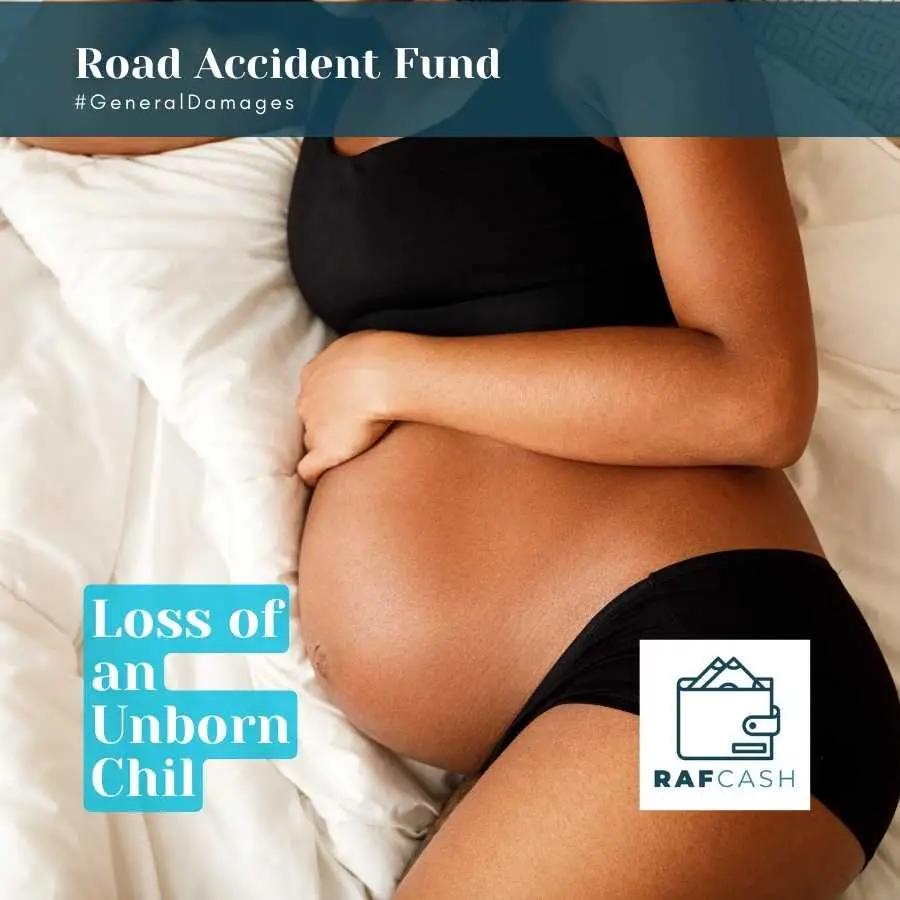
Role of the HPCSA in RAF Claims
Current South African Road Accident Fund (RAF) legislation requires a medical determination of the seriousness of injuries sustained in motor vehicle accidents to determine whether the claimant is entitled to a claim for general damages.
Regulation 3 to the RAF Act sets out the requirement for a third party to submit himself or herself to an assessment by a medical practitioner in accordance with the regulations if a third party wishes to claim general damages from the RAF.
The above-mentioned regulation makes it obligatory for a medical practitioner, defined as “means a person registered as such under the Health Professions Act, 1974 in accordance with these regulations”, to complete a medical assessment in order to ascertain whether a particular injury can be regarded as serious for purposes of the Act.
Such medical assessments are submitted in the form of RAF 4 Serious Injury Assessment Reports.
Contested claims for serious injury are referred to the Health Professions Council of South Africa (HPCSA) Appeal Tribunals for final determination.

DID YOU KNOW…
RAF 4 form (Serious Injury Assessment Report)
According to the RAF Act a medical practitioner has to determine whether or not the victim has suffered a serious injury by undertaking an assessment prescribed in the regulations to the RAF Act.
The RAF 4 report is prepared by the practitioner performing the injury assessment. The medical practitioner must assess the injury in terms of the American Medical Association’s Guides to the Evaluation of Permanent Impairment, 6 ed (the AMA Guides).
If the injury is found to have resulted in 30% or more impairment of the whole person, according to the methods stipulated in the AMA Guides, the injury should be assessed as a serious injury.
This report confirms that the injury is serious enough to warrant the award of compensation to the injured claimant. This report needs to be backed up with medical reports, receipts, financial statements as well as any other documents that support the claim.
Methods for Quantifying Non-Economic Losses
Quantifying non-economic losses is more subjective and less formulaic than calculating financial damages.
- Comparative Analysis: Legal precedents and past cases often serve as a reference point. How have similar injuries and their impacts been valued in the past?
- Individual Factors: Each case is unique, and so is each claim. Factors like age, prior health, lifestyle before the accident, and the claimant’s personal narrative significantly influence the quantification.
- Expert Testimonies: Medical experts, psychologists, and even occupational therapists can provide valuable insights into the extent of the damages, helping to shape a more accurate and fair valuation.
- Legal Guidelines: While there’s no strict formula, legal guidelines and principles offer a framework within which these damages are estimated.
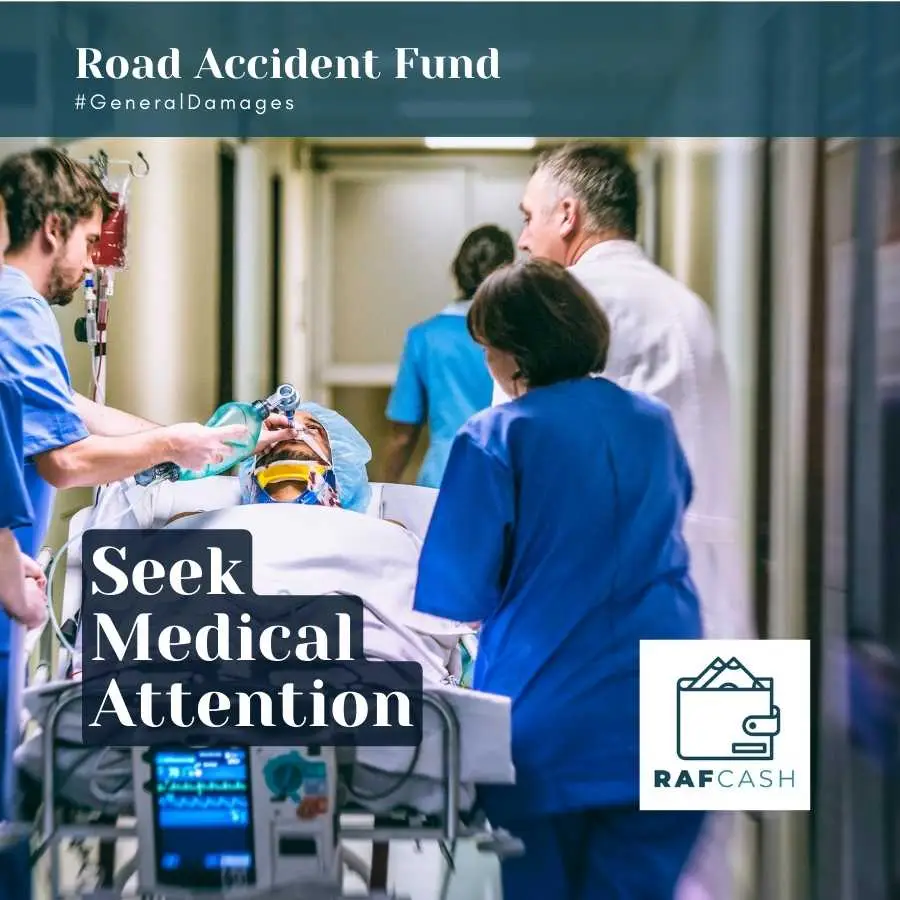
Through this meticulous process of assessment and quantification, the aim is to arrive at a compensation figure that, while it can never truly make up for the losses suffered, seeks to acknowledge and address them in the most equitable way possible.
The process underscores the RAF’s commitment to offering a semblance of solace and recognition to those who have endured life-altering experiences on the road.
Eligibility Criteria for Filing a Claim: Who Can Seek General Damages from the RAF?
When it comes to seeking general damages from South Africa’s Road Accident Fund (RAF), not every case qualifies.
This section outlines the key criteria and limitations that govern who can file a claim for general damages, providing a clear understanding of the RAF’s requirements.
Core Conditions for Filing a Claim
- Serious Injury Requirement: As per RAF regulations, only injuries classified as ‘serious’ are eligible for general damages compensation. This includes injuries causing significant long-term impairment, severe disfigurement, or substantial mental and behavioral disturbances.
- Medical and Legal Documentation: Claimants must provide comprehensive medical reports and legal documents, evidencing the severity of the injuries and their impact on the claimant’s life.
- Time Frame for Filing: The claim must be lodged within specific time limits – 3 years from the date of the accident if the at-fault driver is known, and 2 years if unknown.
- Mandatory Waiting Period: There’s a mandatory 120-day waiting period post-claim lodging before issuing a summons, which must be served within 5 years of the accident date.
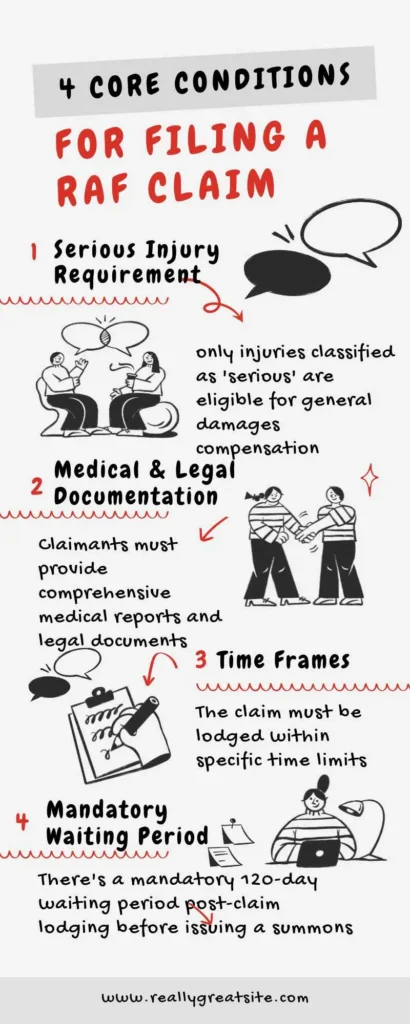
Limitations and Exclusions in Claim Eligibility
- Non-Eligibility for Certain Non-Monetary Losses: South African courts typically don’t award compensation for grief, bereavement, loss of companionship, or other non-clinical distress forms.
- Passenger Limitations: For certain passenger categories, RAF’s liability may be limited, especially when injuries are due solely to the driver’s negligence in the vehicle they were traveling in.
- Exclusions Based on Negligence or Lawful Status: Claims may be denied or reduced if the claimant was found to be significantly negligent or involved in unlawful activities at the time of the accident.
- Unlawful Conduct of the Claimant: If the claimant was engaged in unlawful behavior leading to the accident, this could impact the eligibility for filing a claim.
- Pre-existing Conditions: Injuries or disabilities unrelated to the accident or exacerbated by pre-existing conditions may not be fully covered.
Understanding these criteria is crucial for anyone considering filing a general damages claim with the RAF.
It helps set realistic expectations and ensures that claimants are adequately prepared for the legal process ahead.
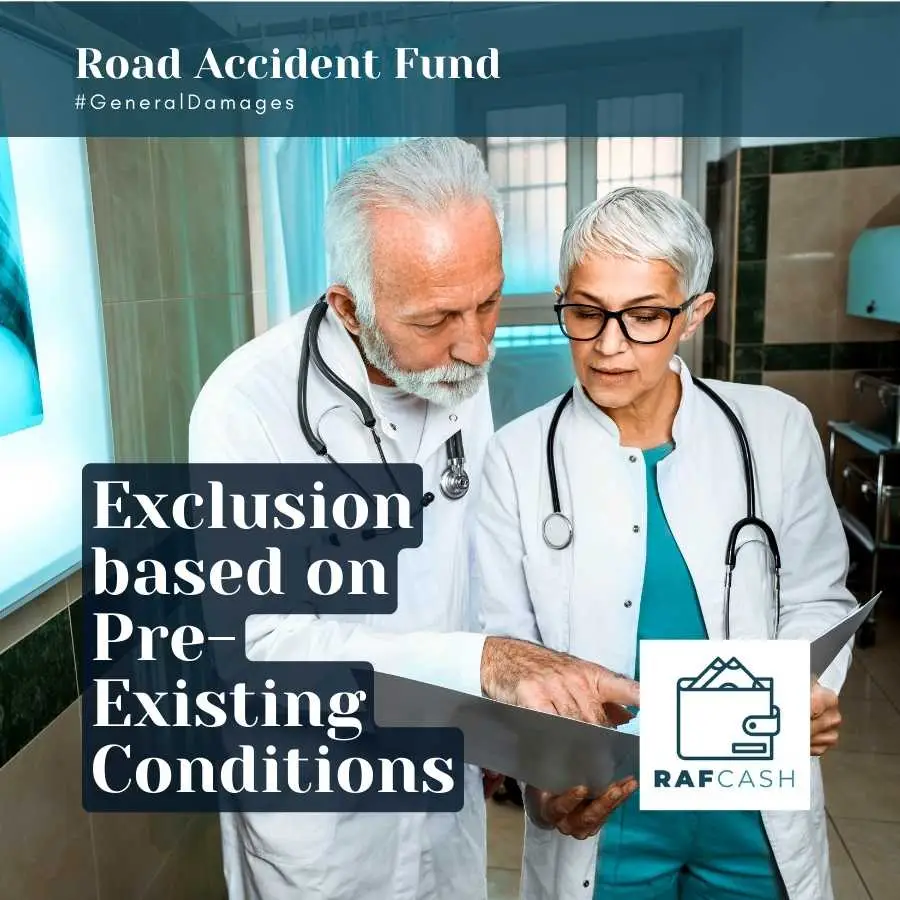
The RAF’s role is to ensure fair compensation within these parameters, providing support to those who have suffered due to motor vehicle accidents on South African roads.
Time Limits for Filing Claims: Navigating the RAF’s Deadlines
Understanding the time limits for filing claims with South Africa’s Road Accident Fund (RAF) is crucial for anyone seeking compensation for injuries sustained in a motor vehicle accident.
This section outlines the specific deadlines that claimants need to be aware of, ensuring that their rights to compensation are not forfeited due to a missed timeline.
Critical Deadlines for RAF Claims
- Standard Time Limit: If the identity of the driver or owner of the vehicle at fault is known, claimants have a period of 3 years from the date of the accident to lodge their claim with the RAF.
- Unknown Driver or Owner: In cases where the driver or owner responsible for the accident cannot be identified (such as hit-and-run scenarios), the claim must be filed within 2 years from the accident date.
- Minors and Legal Incapacity: Special considerations apply to minors or individuals legally incapable of managing their own affairs. In such cases, the time limits may be extended, offering additional time for guardians or legal representatives to lodge a claim.
- Post-Lodgement Waiting Period: After a claim is successfully lodged, a mandatory waiting period of 120 days must be observed before any legal action, such as issuing a summons, can be taken.
- Summons Issuance Window: A crucial aspect to note is that a summons related to the claim must be issued within 5 years from the accident date. This is a binding deadline, and failing to meet it can render the claim unenforceable.
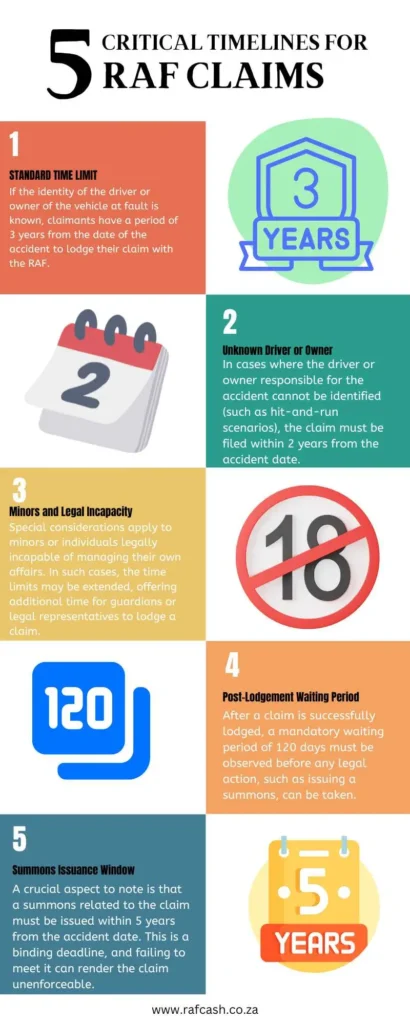
Consequences of Missing Deadlines
- Invalidation of Claims: Missing these deadlines can lead to the invalidation of the claim, meaning that the RAF will not be liable for any compensation.
- Legal Complications: Late submissions or failure to issue a summons in time can lead to complex legal challenges and potential dismissal of the case.
- Loss of Compensation Rights: The most significant impact of not adhering to these timelines is the loss of the right to compensation for damages suffered, which can be a major setback for victims relying on these funds for recovery and rehabilitation.
Tips for Ensuring Timely Filing
- Early Consultation: Engage with a legal expert or attorney specializing in RAF claims as soon as possible after the accident.
- Documentation and Evidence: Gather and prepare all necessary documentation and evidence promptly to avoid delays in filing.
- Regular Follow-Ups: Keep track of your claim’s progress and stay in touch with your legal representative to ensure all deadlines are met.
Adhering to these time limits is essential for a successful claim with the RAF.
Victims of motor vehicle accidents should act promptly and seek professional advice to navigate the claims process effectively and secure the compensation they rightfully deserve.
Documentation and Evidence: Building a Strong RAF General Damages Claim
In pursuing a Road Accident Fund (RAF) general damages claim in South Africa, presenting compelling documentation and evidence is pivotal.
This section aims to guide claimants on effectively documenting pain, suffering, and emotional distress, and underscores the importance of maintaining thorough and precise records.
Essential Documentation for General Damages Claims
- Medical Reports and Records:
- Collect detailed medical reports from doctors, specialists, and therapists that outline the nature and extent of injuries.
- Include records of hospital stays, treatments received, and medications prescribed.
- Psychological Evaluations:
- If psychological trauma is evident, include evaluations from psychologists or psychiatrists that detail the mental and emotional impact of the accident.
- Evidence of ongoing therapy or counseling sessions can strengthen the claim.
- Personal Diary or Journal:
- Keeping a daily journal documenting the pain, discomfort, and how the injuries affect daily life and activities can provide a personal and impactful account.
- Note instances of emotional distress, anxiety, depression, or any psychological changes post-accident.
- Witness Statements:
- Statements from family, friends, or colleagues who can testify to the claimant’s condition and how the accident has impacted their life.
- These can provide a third-party perspective on the claimant’s suffering and lifestyle changes.
- Photographic Evidence:
- Photographs of injuries immediately after the accident and during the recovery process.
- Pictures illustrating the impact on daily life, such as changes in the home environment to accommodate the injury.
- Financial Records:
- Receipts for medical expenses, therapy sessions, and any out-of-pocket costs related to the injury.
- If claiming for loss of earnings, include proof of income prior to the accident.

Importance of Comprehensive Records
- Credibility and Clarity: Detailed and organized documentation lends credibility to the claim and provides a clear narrative of the impact of the accident.
- Quantifying Non-Economic Damages: While non-economic damages like pain and suffering are subjective, thorough documentation helps in their quantification.
- Legal and Medical Scrutiny: Well-documented evidence stands up to the scrutiny of legal and medical professionals involved in assessing the claim.
- Facilitating a Fair Settlement: Comprehensive records can facilitate negotiations for a fair settlement, ensuring that all aspects of the claimant’s suffering are considered.
For claimants navigating the RAF claims process, meticulous documentation and evidence are key to substantiating general damages claims.
By providing a thorough and accurate portrayal of the physical, emotional, and psychological toll of their injuries, claimants enhance their chances of receiving fair and adequate compensation.
As always, consulting with legal professionals experienced in RAF claims can provide additional guidance and support throughout this process.
The Claims Process: Navigating Your Way Through a RAF General Damages Claim
Filing a general damages claim with the Road Accident Fund (RAF) in South Africa involves a series of steps, legal procedures, and necessary documentation.
This guide provides a step-by-step approach to help you navigate the process efficiently and effectively.
Step 1: Initial Assessment and Consultation
- Seek Medical Attention: Immediately after the accident, obtain medical treatment. Your medical records will be crucial in supporting your claim.
- Consult a Legal Professional: Engage with an attorney experienced in RAF claims. They can offer valuable guidance on the viability of your claim and the documentation needed.

Step 2: Gathering Necessary Documentation
- Accident Report: Obtain a copy of the police report if the accident was reported to the South African Police Service (SAPS).
- Medical Records: Compile all medical reports, bills, and records related to your treatment.
- Photographic Evidence: Include photos of your injuries and the accident scene.
- Witness Statements: Gather statements from any witnesses to the accident.
- Personal Documentation: Keep a detailed journal of your recovery process, noting your pain levels, emotional state, and how the injuries impact your daily life.
Step 3: Filing the Claim
- Claim Form Submission: Complete the RAF claim form (RAF 1). Your attorney can assist in ensuring that all necessary details are accurately filled in.
- Attach Supporting Documents: Submit the claim form along with all your supporting documents, including medical reports and expenses, police reports, and witness statements.
- Deadlines: Be aware of the time limits for filing your claim. If the driver or owner of the vehicle at fault is known, the claim must be lodged within three years from the date of the accident. If the driver or owner is unknown, the claim must be lodged within two years.
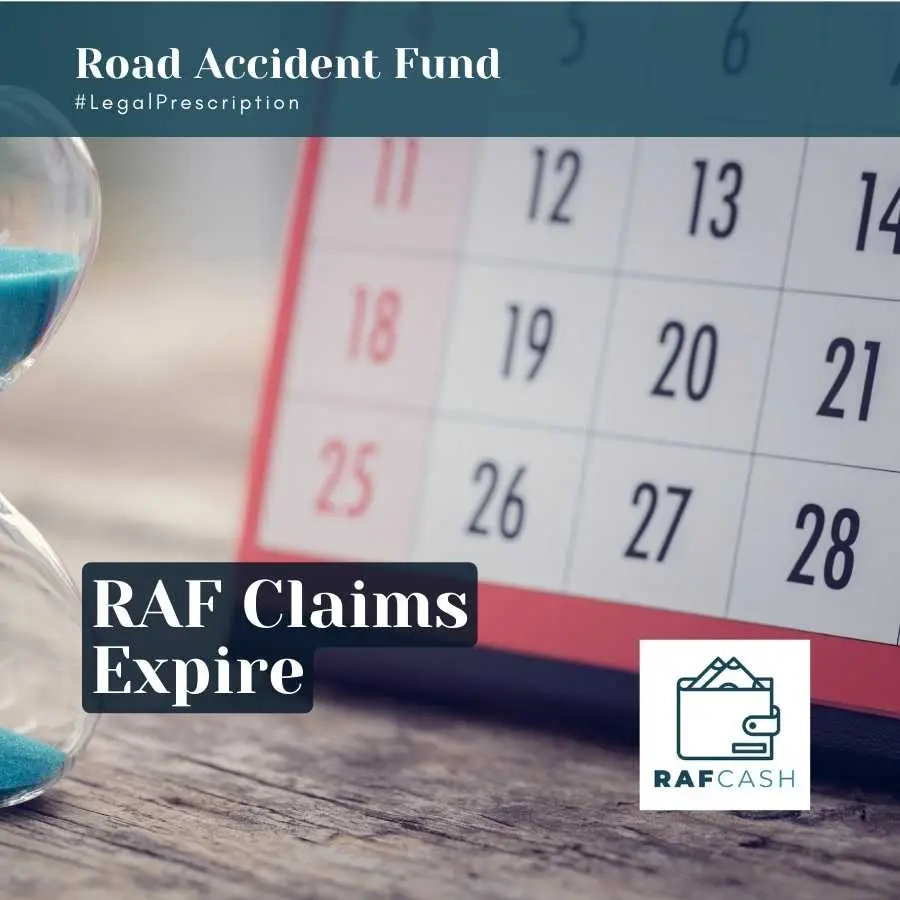
Step 4: RAF’s Assessment of the Claim
- RAF Review: After submission, the RAF will assess your claim. This process includes reviewing your documents and potentially requesting additional information or clarification.
- Serious Injury Assessment: If your injuries are deemed serious, as per RAF’s criteria, a medical practitioner will assess the extent of your injuries and their impact on your life.
Step 5: Settlement and Compensation
- Negotiation: The RAF may make an offer of settlement. Your attorney can negotiate on your behalf to ensure the compensation is fair and covers all your damages.
- Legal Proceedings: If a satisfactory settlement is not reached, your claim may proceed to court, where a judge will determine the compensation amount.
Step 6: Receiving Compensation
- Payment of the Award: Once a settlement is agreed upon or a court award is made, the RAF will process the payment.
- Follow-up: Ensure that the compensation received covers all the aspects of your claim, including general damages for pain and suffering.
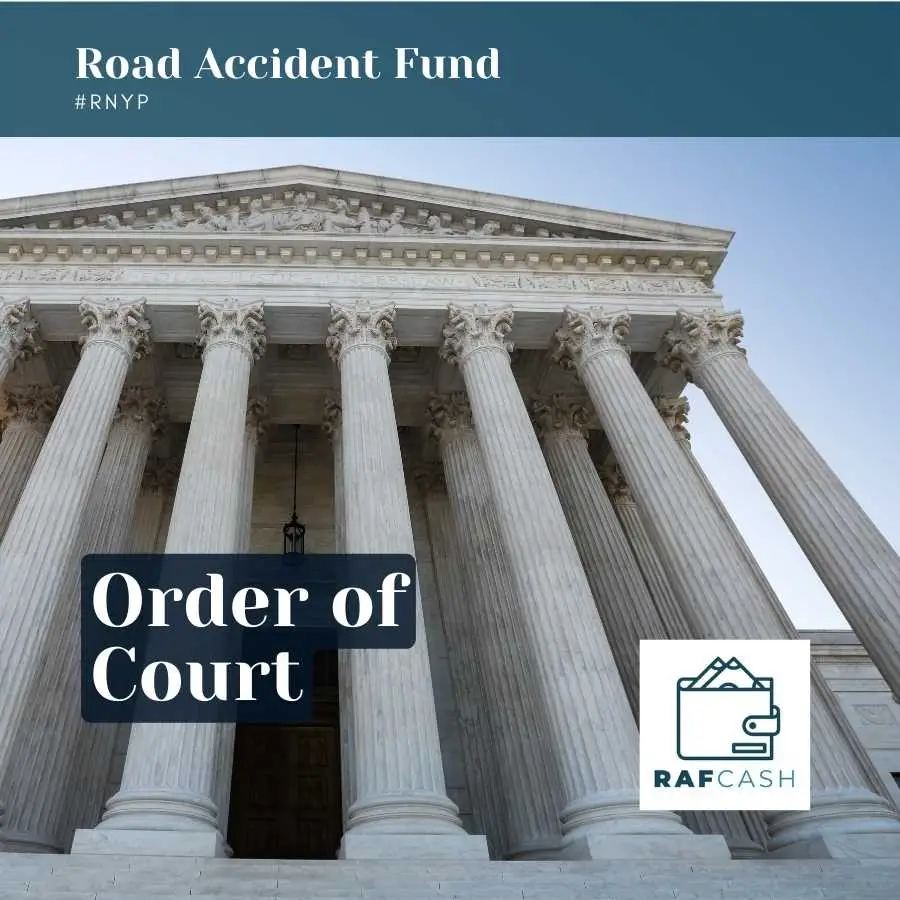
Navigating the RAF general damages claim process requires meticulous documentation, adherence to legal procedures, and an understanding of the RAF’s assessment criteria.
While it can be a complex process, proper guidance and representation can significantly increase the likelihood of a successful claim and fair compensation.
Remember, the key to a successful RAF claim lies in thorough preparation and expert legal assistance.
Legal Representation: Navigating RAF Claims with the Right Attorney
When pursuing a general damages claim with the Road Accident Fund (RAF), the role of legal representation cannot be overstated. Attorneys specializing in RAF claims play a pivotal role in guiding claimants through the intricate legal landscape, ensuring that their rights are protected and that they receive fair compensation.
The process of selecting the right attorney is crucial. Your attorney is not just a legal advisor but also your advocate and guide throughout the claim process. It’s essential to choose someone who is not only knowledgeable in RAF legislation but also empathetic to your situation.
Look for legal professionals with a proven track record in handling RAF claims successfully. They should have a deep understanding of the nuances of personal injury law and be well-versed in the complexities of general damages claims.
Effective communication is a key attribute to look for in your legal representation. You want an attorney who can explain legal jargon in layman’s terms, keeping you informed and involved at every step of the claim process.
They should be accessible, responsive to your queries, and proactive in updating you on the progress of your case.
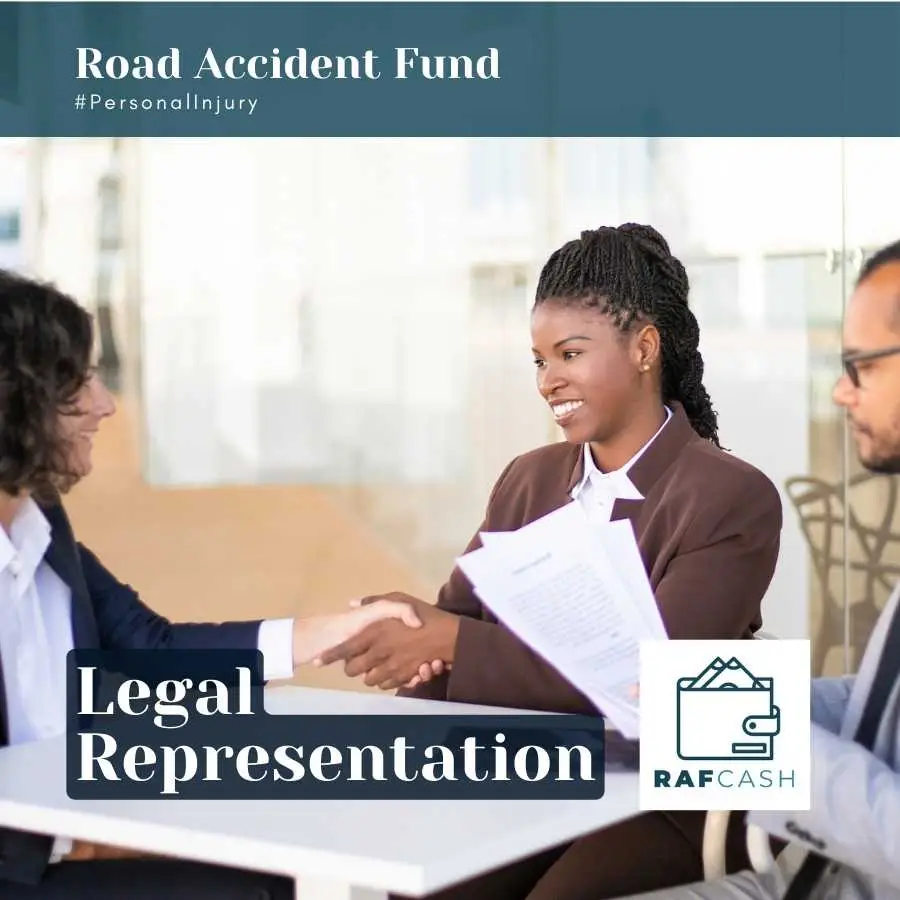
Transparency in legal fees is another critical factor.
Many attorneys operate on a contingency basis, meaning they only get paid if your claim is successful.
Ensure you understand their fee structure, what costs might be incurred during the process, and how these will be handled.
Your relationship with your attorney is a partnership. Choose someone who respects this dynamic, values your input, and is committed to achieving the best possible outcome for your claim.
A good attorney not only navigates the legal process but also provides support and reassurance during what can be a challenging time.
In summary, the right legal representation is integral to the success of your RAF general damages claim.
An experienced, communicative, and empathetic attorney will not only streamline the legal process but also enhance your chances of receiving the compensation you rightfully deserve.
Case Studies and Examples: Illuminating the RAF General Damages Claim Process
Exploring real-life case studies provides invaluable insights into the complexities of RAF general damages claims.
Each case presents unique challenges and learning opportunities, highlighting how the nuances of injury assessment, legal interpretations, and individual circumstances converge in determining the outcomes of these claims.
Through these examples, we gain a deeper understanding of how the Road Accident Fund operates in South Africa, particularly in addressing serious injury claims and quantifying non-monetary losses.
These case studies serve as a practical guide, illustrating the legal journey from injury to compensation and the critical factors that influence claim success.
Case Study 1: The Dispute Resolution Process in Serious Injury Assessment
In the case involving Mthabiseni Maqhutyana and Nokulunga Mnama against the Road Accident Fund (RAF), the central issue pertains to the determination of serious injuries for the purpose of claiming general damages.
Both plaintiffs had their claims for serious injury assessment reports initially rejected by the RAF.
The rejection led to the invocation of a dispute resolution process involving the Health Professions Council of South Africa (HPCSA). The matter highlights the complexity of RAF claims, especially when serious injuries are contested, and underscores the importance of the dispute resolution process in determining the eligibility for general damages claims.
The RAF’s obligation to compensate for non-pecuniary losses is limited to serious injuries, with the determination of ‘seriousness’ following a specific administrative process outlined in the RAF legislation and regulations.
Download and read the full court order here.

Case Study 2: The Intricacies of Proving ‘Serious Injury’
In the case of the Road Accident Fund v Oupa William Lebeko, the core issue revolved around the assessment of ‘serious injury’ for the purpose of a general damages claim. Lebeko, a pedestrian, was injured in a collision and sought compensation for general damages from the RAF.
However, the RAF contested the severity of his injuries. According to RAF regulations, a ‘serious injury’ must be medically determined to validate a general damages claim. Lebeko’s claim initially lacked this verification. The court addressed the procedural nuances of the RAF’s serious injury assessment, emphasizing the importance of following the prescribed method.
The case underlines the complex nature of proving ‘serious injury’ in RAF claims and the role of medical assessments in this process.
Download and read the full court order here

Case Study 3: The Legal Battle in Severity Assessment of Injuries
In the case detailed in the court order, the Road Accident Fund (RAF) v. Bethwell Maphiri, the focus was on the assessment of ‘serious injury’ for a general damages claim.
Maphiri, a victim of a motor vehicle collision, pursued compensation from the RAF.
His claim’s crux lay in the medical determination of his injuries’ severity. The RAF challenged the extent of these injuries, thus bringing the case to court.
This situation exemplifies the legal complexities inherent in RAF claims, particularly when the severity of injuries and entitlement to general damages are contested.
The case underscores the critical role of medical assessments and legal interpretations in determining the eligibility for general damages claims under RAF policy.
Download and read the full court order here

Case Study 4: Managing the Quantum Proceedings and Fund Administration
In the legal case of the Road Accident Fund versus C N Laubscher, Mr. Christian Nicolai Laubsher, who was injured in a motor vehicle accident at the age of 18, claimed against the RAF.
The court initially settled on the RAF accepting 80% liability for Laubscher’s proven damages. The quantum proceedings aimed to determine general damages, the method of calculating past and future loss of earnings, and the administration of the funds for Laubscher.
The court eventually ordered the RAF to pay R800,000 for general damages and additional amounts for past medical expenses and loss of earning capacity. The case also addressed the need for a curator bonis to manage the funds, acknowledging Laubscher’s inability to do so due to his injuries.
The appeal focused on the apportionment of general damages and the administration of Laubscher’s funds.
Download and read the full court order here

Case Study 5: Quantifying Non-Monetary Losses in Tragic Circumstances
In the legal dispute involving the Road Accident Fund (RAF) and Petrus Jacobus Delport, acting as the curator ad litem for Helen van Rooyen, the matter revolved around the appropriate compensation for the horrendous and permanent injuries Helen suffered in a motor vehicle collision.
The case focused on the assessment of damages for her loss of earning capacity and general damages.
The Pretoria High Court awarded a total sum of R3,616,697.57, broken down into past medical expenses, damages for loss of earning capacity, and general damages for pain, suffering, and loss of amenities of life.
The RAF appealed the awards for loss of earning capacity and general damages.
The court’s decision hinged on various factors, including the severity of Helen’s injuries and their impact on her life, highlighting the complexities involved in quantifying non-monetary losses in such tragic circumstances.
Download and read the full court order here

These case studies underscore the intricate nature of RAF general damages claims.
They reveal how critical factors like injury severity, medical assessments, and legal strategies shape the outcomes of these claims.
The journey from injury to compensation is rarely straightforward, often requiring expert legal guidance and a thorough understanding of RAF policies and procedures.
These examples serve as a testament to the resilience of claimants and the diligence of legal professionals in navigating this challenging landscape, ultimately striving for justice and fair compensation.
How Large are General Damages Claims
Below are three examples indicating the financial value of general damages RAF claims.
Please note that each case is different. Individual determination is based on the unique aspects of each case separately.
Therefore while illustrative, these values should not influence your expectations of potential payout.
Example 1
The plaintiff, BR (names redacted for privacy of MVA victims), sustained various injuries including a back injury with multiple transverse process fractures between L2/L4 and a severe brain injury with a depressed skull fracture, small subdural bleeding, and a minor haemorrhagic contusion.
The court ordered the payment of general damages for the injuries sustained by the victim in the motor vehicle collision, acknowledging the neuropsychological impact and the extent of physical injuries.
The amount awarded for general damages was R 800,000.
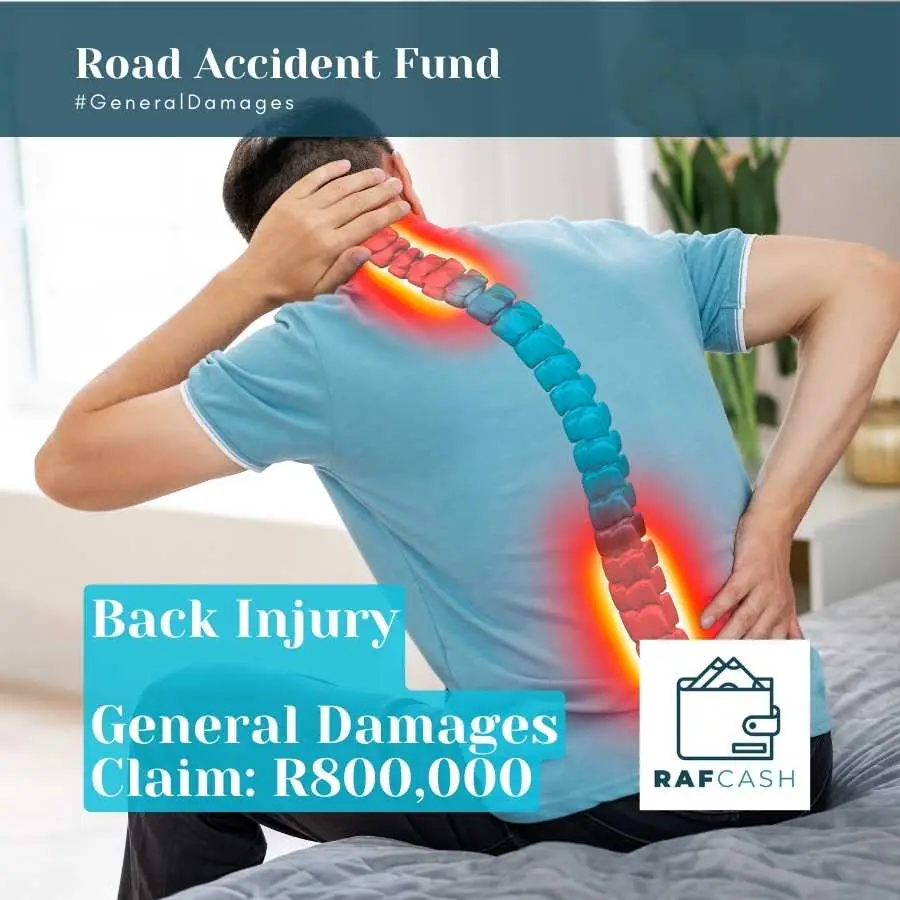
Example 2
The plaintiff, OWL, suffered a compound fracture of the right femur and a concussive brain injury as a result of a motor vehicle collision.
The court’s decision on the general damages claim was postponed pending compliance with regulation 3, which relates to the assessment of serious injury.
Since the matter was postponed for the determination of the plaintiff’s claim for general damages, no specific amount was awarded in this court order.
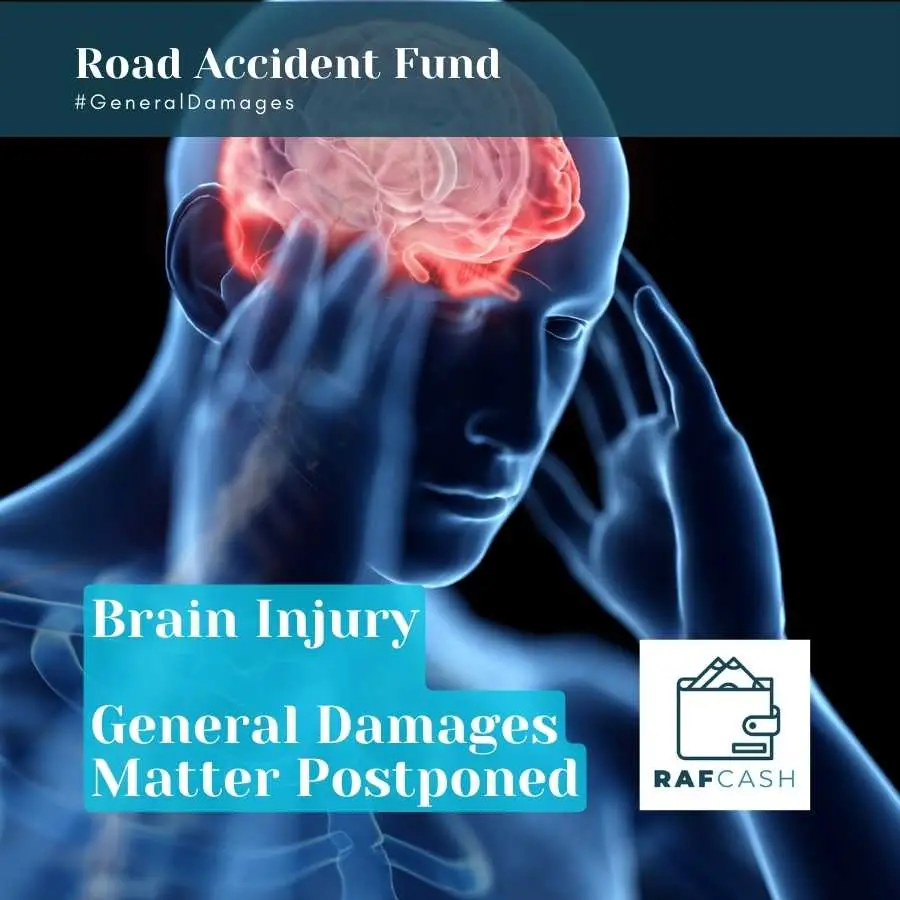
Example 3
The patient, HvR, suffered severe, permanent injuries from a motor collision on 16 January 1997. These injuries included a severe head injury, injuries to the chest, left wrist, pelvis, left thigh, and lower leg, leading to total disability.
The general damages were awarded for the significant pain, suffering, and loss of amenities of life due to the collision, acknowledging the patient’s profound disablement and dependence on others.
The general damages award was R1,250,000
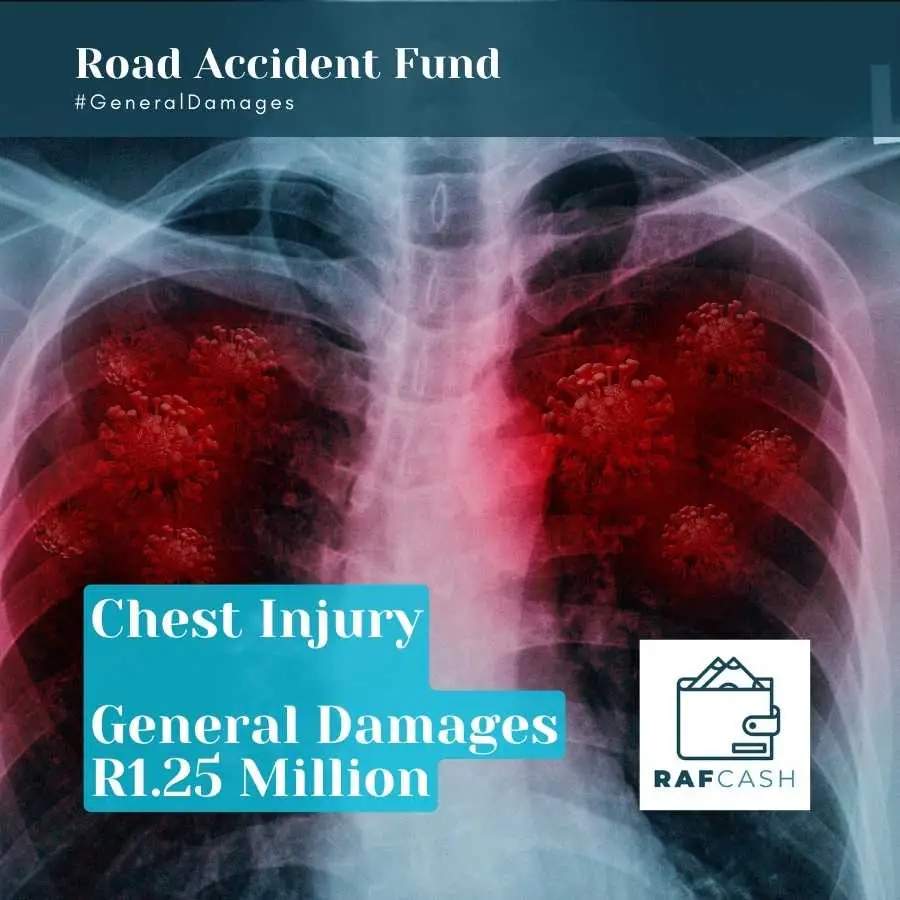
Note: The awards obtained above, although true, are specific to each case. Readers should not draw general conclusions based on specific case studies. Rather qualified legal expertise should be consulted.
Psychological and Emotional Support
In South Africa, there are several resources available for claimants and their families dealing with the emotional and psychological aftermath of an accident.
These resources offer a range of support, including legal assistance, helplines for various types of abuse, and support for mental health issues.
Legal Support
For those seeking compensation from the Road Accident Fund (RAF), it’s advisable to contact experienced personal injury attorneys. They can help in collecting evidence to support the claim, increasing the likelihood of winning the case and getting maximum compensation.
Firms specializing in RAF claims (search online for ‘personal injury attorney’ or ‘MVA lawyer’ or ‘RAF law firm’) often operate on a “no win, no fee” basis, providing legal support that’s effective, ethical, and caring.
Gauteng Provincial Government Victim Empowerment Program
This program provides a range of services for people who have suffered harm, trauma, and material loss through violence, crime, natural disasters, human accidents, or socio-economic conditions.
The goal is to restore the loss or damage caused by criminal acts and their consequences through various actions intended to empower the victim. Assistance is provided depending on the type of trauma suffered, and it’s available to individuals and families.
To access the service, individuals can visit any of the Gauteng Department of Social Development offices.
South African Police Service (SAPS)
In cases of domestic violence or sexual assault, SAPS can assist in finding medical attention, shelter, and victim counseling. The SAPS emergency number is 10111. Alternatively you can access other contact details on their website https://www.saps.gov.za/contacts/
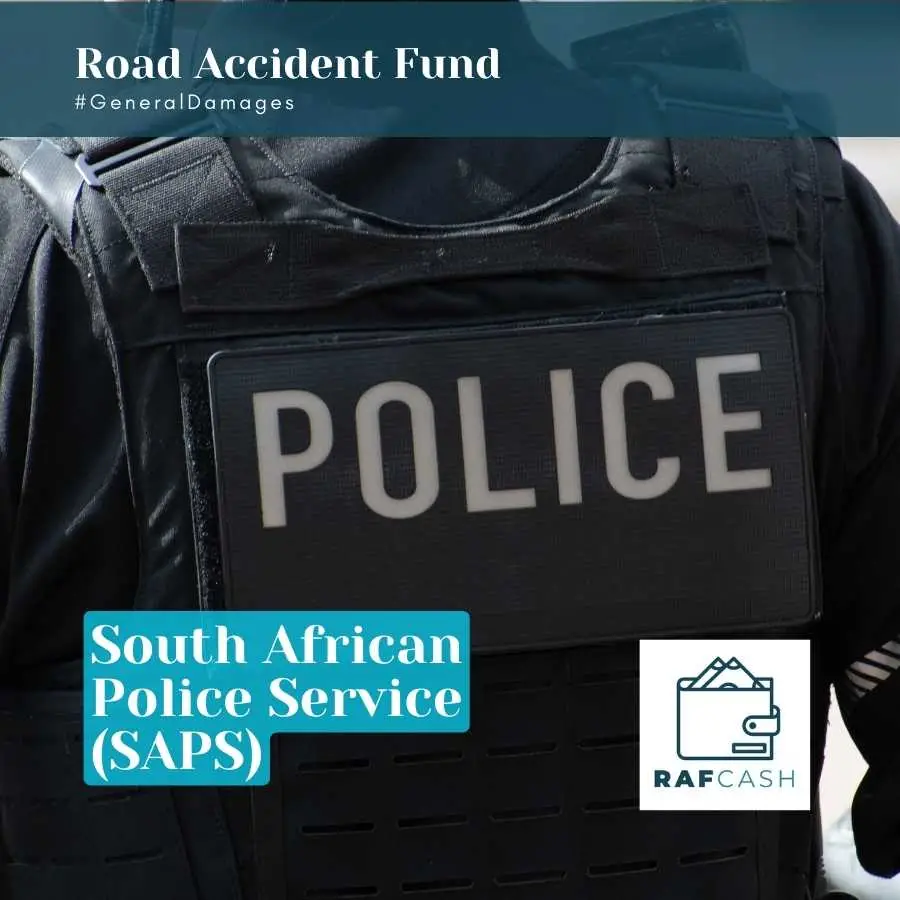
Childline South Africa
This non-profit organization helps abused children and their families with a free counseling service, dealing with issues such as physical and sexual abuse, substance abuse, behavioral problems, trafficking, and legal advice.
The toll-free helpline is 116, and they can be emailed at [email protected].
Families South Africa (Famsa)
Famsa provides counseling and education to help improve marriages and families. It assists in cases of domestic violence and trauma, divorces, and mediation.
They can be reached at 011 975 7106/7.
The Trauma Centre
Provides trauma counseling and violence prevention services for people affected by violence.
Reach them at 021 465 7373 or [email protected].
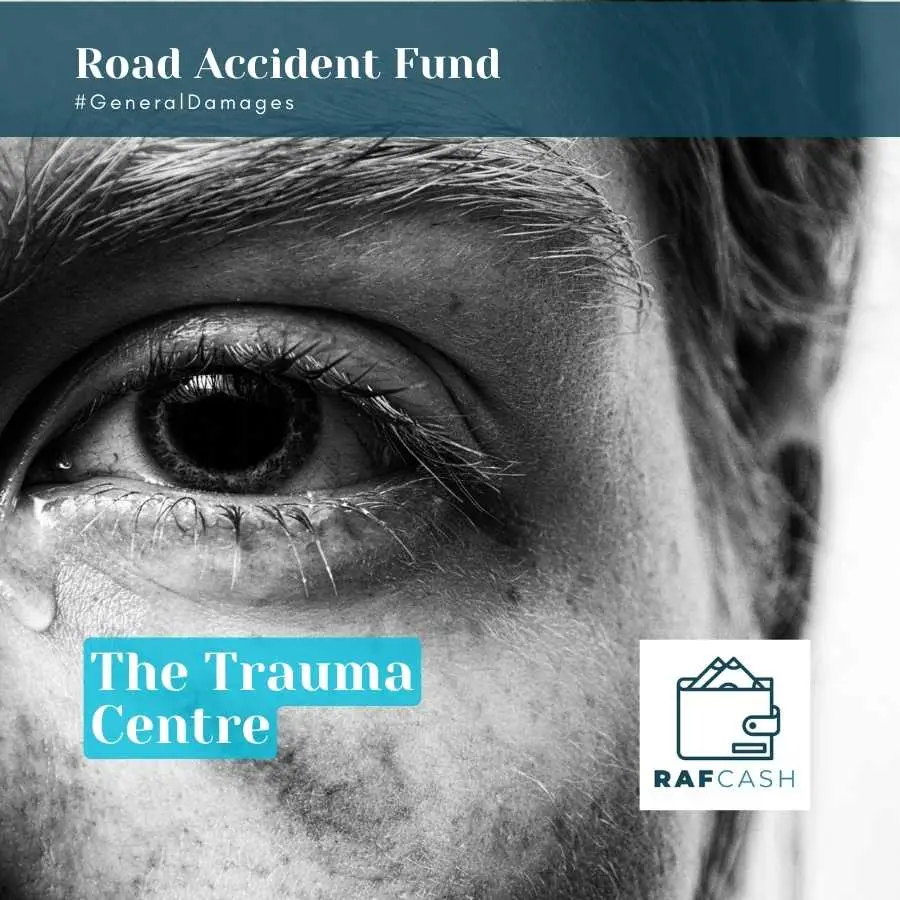
Conclusion: Navigating the Path of RAF General Damages Claims in South Africa
In summarizing the landscape of Road Accident Fund (RAF) general damages claims in South Africa, it is evident that such claims constitute a critical component in addressing the aftermath of motor vehicle accidents. These claims provide monetary recognition for the non-quantifiable, yet deeply impactful, non-monetary losses experienced by accident victims, such as pain and suffering, loss of amenities of life, and emotional distress.
The process of claiming general damages under the RAF, while complex, is integral in ensuring that victims of road accidents receive the justice and compensation they deserve. From understanding the nuances of what constitutes a ‘serious injury’ to navigating the legalities of filing a claim within prescribed time limits, the journey demands careful consideration and adherence to specific criteria.
Legal representation plays a pivotal role in this process. The expertise of skilled attorneys can significantly influence the outcome of a claim, making their selection an important decision for claimants. Moreover, the emotional and psychological support available to victims and their families cannot be overstated. These resources provide much-needed comfort and guidance during challenging times.
In conclusion, while the path to obtaining fair compensation for general damages can be fraught with complexities, it is a journey worth undertaking. It is a path that leads not only to financial redress but also towards healing and closure for those affected by the unforeseen tragedies on South Africa’s roads. As we continue to navigate this landscape, it is crucial to remain informed, supported, and vigilant in the pursuit of justice and fair compensation.
Understanding the RAF ecosystem is vital in successfully navigating general damages claims. Don’t let the complexities deter you. Stay informed and educated by subscribing to our insightful newsletter. Visit RAF Cash and empower yourself with the knowledge and tools needed to manage your RAF claim effectively.
Glossary
General Damages: Compensation for non-monetary losses, such as pain and suffering, emotional distress, and loss of life quality due to an injury.
Specific Damages: Monetary compensation for tangible losses like medical bills, lost wages, and rehabilitation costs.
Whole Person Impairment (WPI): A percentage measure used to evaluate the severity of an injury’s impact on an individual’s overall abilities.
Curator Bonis: A court-appointed individual responsible for managing the financial affairs and property of someone unable to do so.
Quantification: The process of determining the monetary value of non-tangible losses like pain and suffering.
Non-Pecuniary Damages: Compensation for losses that don’t have a direct monetary value, similar to general damages.
Serious Injury: Under RAF, an injury involving 30% or greater Whole Person Impairment or resulting in long-term impairment, severe disfigurement, or serious mental disturbances.
Solatium: A form of compensation for pain, suffering, and loss of life’s amenities due to an injury.
RAF 4 Serious Injury Assessment Report: A medical report form used in South Africa to assess the severity of injuries for RAF claims.
Health Professions Council of South Africa (HPCSA): The regulatory body for health care practitioners in South Africa, involved in RAF claim disputes.
Emotional Distress: Psychological suffering caused by an accident or injury, including anxiety, depression, and trauma.
Loss of Amenities: The loss of enjoyment of life’s activities and pleasures due to an injury or accident.
Physical Disfigurement: Permanent alteration of one’s physical appearance due to an injury or accident.
Loss of Consortium: Loss of companionship and support, typically in the context of a marital relationship, due to an injury.
Bereavement: Grief and mourning following the death of a loved one, not typically compensated for in RAF claims.
Frequently Asked Questions
How Is 'Serious Injury' Defined for RAF General Damages Claims?
Serious injury in RAF claims involves injuries with 30% or greater Whole Person Impairment, long-term impairment, severe disfigurement, or serious mental disorders.
Can Emotional Distress Be Claimed Under General Damages in RAF Claims?
Yes, emotional distress can be claimed as part of general damages for the psychological impact of the injuries sustained in the accident.
What Time Limits Apply to Filing a RAF General Damages Claim?
For identified drivers/owners, claims must be lodged within 3 years of the accident date; if unidentified, within 2 years.
What Documentation Is Necessary for Proving Pain and Suffering in a RAF Claim?
A daily journal, therapy records, doctor’s notes, and testimonies from friends and family are vital for documenting pain and suffering.
Can I File a RAF Claim Without a Lawyer?
Yes, but legal representation is recommended for navigating complex procedures and ensuring proper documentation and claim submission.
Are There Limits on the Amount That Can Be Claimed for General Damages?
The amount is at the court’s discretion, based on the severity of the injury, age, health status, and life impact, without a predefined cap.
What If My General Damages Claim Is Rejected by the RAF?
In case of rejection, the dispute can be resolved through processes involving the Health Professions Council of South Africa or legal channels.
How Long Does the RAF Claims Process Usually Take?
The duration varies, but after a mandatory waiting period of 120 days post-claim lodging, legal proceedings can extend for several months or years.
Can General Damages Claims Cover Future Medical Expenses?
General damages primarily cover non-economic losses; future medical expenses are usually categorized under specific damages.
Is It Possible to Appeal a RAF Claim Decision?
Yes, claimants can appeal RAF decisions, often requiring additional legal proceedings and possibly engaging higher judicial authorities.

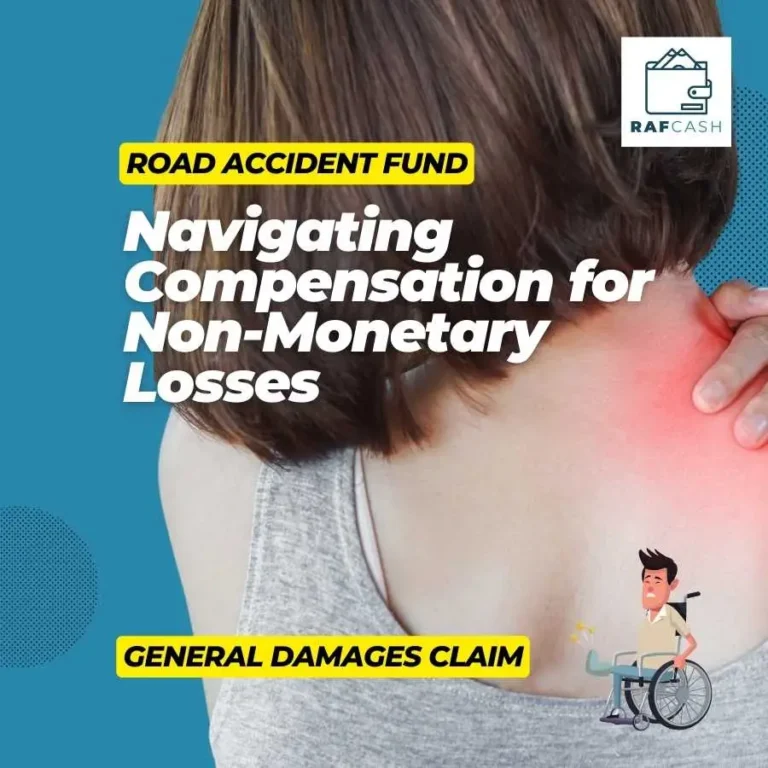

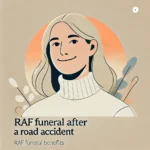
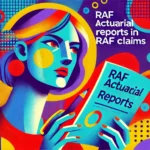

One Response
Thanks for information